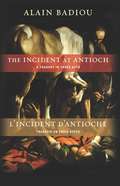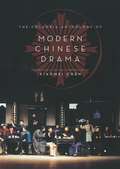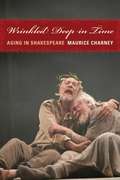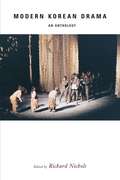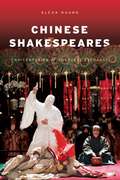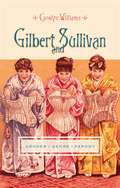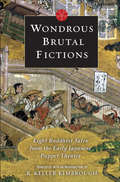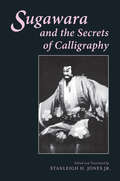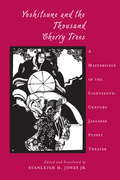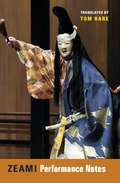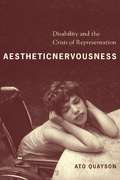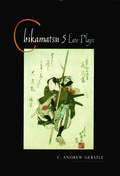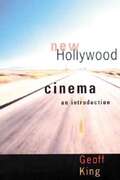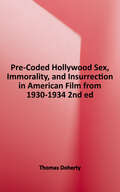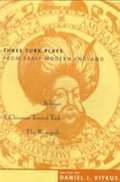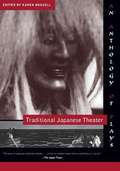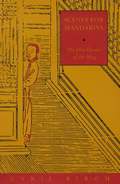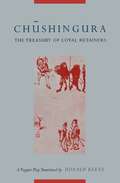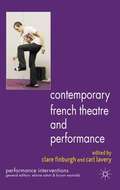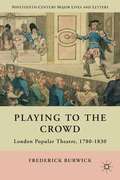- Table View
- List View
The Incident at Antioch / L’Incident d’Antioche: A Tragedy in Three Acts / Tragédie en trois actes (Insurrections: Critical Studies in Religion, Politics, and Culture)
by Alain BadiouThe Incident at Antioch is a key play marking Alain Badiou's transition from classical Marxism to a "politics of subtraction" far removed from party and state. Written with striking eloquence and extraordinary poetic richness, and shifting from highly serious emotional and intellectual drama to surreal comic interlude, the work features statesmen, workers, and revolutionaries struggling to reconcile the nature and practice of politics.This bilingual edition presents L'Incident d'Antioche in its original French and, on facing pages, an expertly executed English translation. Badiou adds a special preface, and an introduction by the scholar Kenneth Reinhard connects the play to Paul Claudel's The City, Saint Paul and the early history of the Church, and the innovative mathematical thinking of Paul Cohen. The translation includes Susan Spitzer's extensive notes clarifying allusions and quotations and hinting at Badiou's intentions. An interview with Badiou encompasses the play's settings, themes, and events, as well as his ongoing literary and conceptual experimentation on stage and off.
The Columbia Anthology of Modern Chinese Drama
by Xiaomei ChenThe first of its kind in English, this anthology presents translations of twenty-two popular plays published between 1919 and 2000, accompanied by an introduction to the historical, cultural, and aesthetic evolution of twentieth-century Chinese spoken drama. Primarily comprising works from the People's Republic of China, though including representative plays from Hong Kong and Taiwan, this collection showcases more than the revolutionary rethinking of Chinese theater and performance that began in the late Qing dynasty. It also reflects the formation of Chinese national and gender identities during a period of tremendous social and political change, as well as the genesis of contemporary attitudes toward the West.Early twentieth-century Chinese drama embodies the uncertainty and anxiety brought on by modernism, socialism, political conflict, and war. After 1949, the PRC theater paints a complex portrait of the rise of Communism in China, with the ideals of Chinese socialism juxtaposed against the sacrifices made for a new society. The Cultural Revolution promoted a "model theater" cultivated from the achievements of earlier, leftist spoken drama, despite the fact that this theater arose from the destruction of old culture. Post-Mao drama addresses the Chairman's legacy and the attempts of a wounded nation to reexamine its cultural roots. Taiwan's spoken drama uniquely synthesizes regional and foreign traditions, and Hong Kong's spoken drama sparkles as a hybrid of Chinese and Western influences. Immensely valuable for scholars of cross-disciplinary, comparative, and performance study, this anthology offers essential perspective on the theatricality and representation of political life.
The Columbia Anthology of Modern Chinese Drama (Weatherhead Books on Asia)
by Ed. Chen XiaomeiThe first of its kind in English, this anthology translates twenty-two popular Chinese plays published between 1919 and 2000, accompanied by a critical introduction to the historical, cultural, and aesthetic evolution of twentieth-century Chinese spoken drama. Primarily comprising works from the People's Republic of China, though including representative plays from Hong Kong and Taiwan, this collection not only showcases the revolutionary rethinking of Chinese theater and performance that began in the late Qing dynasty. It also highlights the formation of Chinese national and gender identities during a period of tremendous social and political change, along with the genesis of contemporary attitudes toward the West.Early twentieth-century Chinese drama embodies the uncertainty and anxiety brought on by modernism, socialism, political conflict, and war. After 1949, PRC theater painted a complex portrait of the rise of communism in China, with the ideals of Chinese socialism juxtaposed against the sacrifices made for a new society. The Cultural Revolution promoted a "model theater" cultivated from the achievements of earlier, leftist spoken drama, even though this theater arose from the destruction of old culture. Post-Mao drama addresses the socialist legacy and the attempts of a wounded nation to reexamine its cultural roots. Taiwan's spoken drama synthesizes regional and foreign traditions, and Hong Kong's spoken drama sparkles as a hybrid of Chinese and Western influences. Immensely valuable for cross-disciplinary, comparative, and performance study, this anthology provides essential perspective on China's theatricality and representation of political life.
Wrinkled Deep in Time: Aging in Shakespeare
by Maurice CharneyShakespeare was acutely aware of our intimate struggles with aging. His dramatic characters either prosper or suffer according to their relationship with maturity, and his sonnets eloquently explore time's ravaging effects. "Wrinkled deep in time" is how the queen describes herself in Antony and Cleopatra, and at the end of King Lear, there is a tragic sense that both the king and Gloucester have acquired a wisdom they otherwise lacked at the beginning of the play. Even Juliet matures considerably before she drinks Friar Lawrence's potion, and Macbeth and his wife prematurely grow old from their murderous schemes.Drawing on historical documents and the dramatist's own complex depictions, Maurice Charney conducts an original investigation into patterns of aging in Shakespeare, exploring the fulfillment or distress of Shakespeare's characters in combination with their mental and physical decline. Comparing the characterizations of elderly kings and queens, older lovers, patriarchal men, matriarchal women, and the senex-the stereotypical old man of Roman comedy-with the history of life expectancy in Shakespeare's England, Charney uncovers similarities and differences between our contemporary attitudes toward aging and aging as it was understood more than four hundred years ago. From this dynamic examination, a new perspective on Shakespeare emerges, one that celebrates and deepens our knowledge of his subtler themes and characters.
Modern Korean Drama: An Anthology
by Richard NicholsCarefully selected and represented, the plays in this collection showcase both the fantastic and the realistic innovations of Korean dramatists during a time of rapid social and historical change. Stretching from 1962 to 2004, these seven works tackle major subjects, such as the close of the Choson dynasty and the aftermath of the Korean War, while delving into trenchant cultural issues, such as the marginalization of students who rebel against mainstream education and the role of traditional values in a materialistic society. Longtime scholar of Korea and its vibrant, politically acute theater, Richard Nichols opens with a general overview of modern Korean drama since 1910 and concludes with an appendix describing theater production and audience attendance in Seoul. He chooses works that aren't just for Korean audiences. These texts confront universal themes and situations, tackling the problem of ambition, the trouble with fidelity, and the complexity of sexual and interpersonal relationships. Nichols situates each work critically, historically, and culturally, including brief biographies of playwrights and extensive notes. A bibliography also provides alternative readings and the titles of additional plays currently available in English. Primed for production, these skillful translations provide Western directors with exciting new material for the stage. At the same time, they offer students and scholars a sophisticated survey of the modern Korean dramatic tradition.
Chinese Shakespeares: Two Centuries of Cultural Exchange (Global Chinese Culture)
by Alexa HuangFor close to two hundred years, the ideas of Shakespeare have inspired incredible work in the literature, fiction, theater, and cinema of China, Taiwan, and Hong Kong. From the novels of Lao She and Lin Shu to Lu Xun's search for a Chinese "Shakespeare," and from Feng Xiaogang's martial arts films to labor camp memoirs, Soviet-Chinese theater, Chinese opera in Europe, and silent film, Shakespeare has been put to work in unexpected places, yielding a rich trove of transnational imagery and paradoxical citations in popular and political culture. Chinese Shakespeares is the first book to concentrate on both Shakespearean performance and Shakespeare's appearance in Sinophone culture and their ambiguous relationship to the postcolonial question. Substantiated by case studies of major cultural events and texts from the first Opium War in 1839 to our times, Chinese Shakespeares theorizes competing visions of "China" and "Shakespeare" in the global cultural marketplace and challenges the logic of fidelity-based criticism and the myth of cultural exclusivity. In her critique of the locality and ideological investments of authenticity in nationalism, modernity, Marxism, and personal identities, Huang reveals the truly transformative power of Chinese Shakespeares.
Gilbert and Sullivan: Gender, Genre, Parody
by Carolyn WilliamsLong before the satirical comedy of The Daily Show and The Colbert Report, the comic operas of Gilbert and Sullivan were the hottest send-ups of the day's political and cultural obsessions. Gilbert and Sullivan's productions always rose to the level of social commentary, despite being impertinent, absurd, or inane. Some viewers may take them straight, but what looks like sexism or stereotype was actually a clever strategy of critique. Parody was a powerful weapon in the culture wars of late nineteenth-century England, and with defiantly in-your-face sophistication, Gilbert and Sullivan proved popular culture could be intellectually as well as politically challenging. Carolyn Williams underscores Gilbert and Sullivan's creative and acute understanding of cultural formations. Anxiety drives the troubled mind in the "nightmare" patter song of Iolanthe and is vividly realized in the sexual and economic phrasing of Lord Chancellor's lyrics. The modern body appears automated and performative in the "railway" song of Thespis, mirroring Charlie Chaplin's factory worker in the film, Modern Times. Williams also illuminates the use of magic in The Sorcerer, the parody of nautical melodrama in H.M.S. Pinafore, the ridicule of Victorian poetry in Patience, the autoethnography of The Mikado, the role of gender in Trial by Jury, and the theme of illegitimacy in The Pirates of Penzance.
Gilbert and Sullivan: Gender, Genre, Parody (Gender and Culture Series)
by Carolyn WilliamsLong before the satirical comedy of The Daily Show and The Colbert Report, the comic operas of W. S. Gilbert and Arthur Sullivan were the hottest send-ups of the day's political and cultural obsessions. Gilbert and Sullivan's productions always rose to the level of social commentary, despite being impertinent, absurd, or inane. Some viewers may take them straight, but what looks like sexism or stereotype was actually a clever strategy of critique. Parody was a powerful weapon in the culture wars of late-nineteenth-century England, and with defiantly in-your-face sophistication, Gilbert and Sullivan proved that popular culture can be intellectually as well as politically challenging.Carolyn Williams underscores Gilbert and Sullivan's creative and acute understanding of cultural formations. Her unique perspective shows how anxiety drives the troubled mind in the Lord Chancellor's "Nightmare Song" in Iolanthe and is vividly realized in the sexual and economic phrasing of the song's patter lyrics. The modern body appears automated and performative in the "Junction Song" in Thespis, anticipating Charlie Chaplin's factory worker in Modern Times. Williams also illuminates the use of magic in The Sorcerer, the parody of nautical melodrama in H.M.S. Pinafore, the ridicule of Victorian aesthetic and idyllic poetry in Patience, the autoethnography of The Mikado, the role of gender in Trial by Jury, and the theme of illegitimacy in The Pirates of Penzance. With her provocative reinterpretation of these artists and their work, Williams recasts our understanding of creativity in the late nineteenth century.
Wondrous Brutal Fictions: Eight Buddhist Tales from the Early Japanese Puppet Theater
by R. Keller KimbroughWondrous Brutal Fictions presents eight seminal works from the seventeenth-century Japanese sekkyo and ko-joruri puppet theaters, many translated into English for the first time. Both poignant and disturbing, they range from stories of cruelty and brutality to tales of love, charity, and outstanding filial devotion, representing the best of early Edo-period literary and performance traditions and acting as important precursors to the Bunraku and Kabuki styles of theater.As works of Buddhist fiction, these texts relate the histories and miracles of particular buddhas, bodhisattvas, and local deities. Many of their protagonists are cultural icons, recognizable through their representation in later works of Japanese drama, fiction, and film. The collection includes such sekkyo "sermon-ballad" classics as Sansho Dayu, Karukaya, and Oguri, as well as the "old joruri" plays Goo-no-hime and Amida's Riven Breast. R. Keller Kimbrough provides a critical introduction to these vibrant performance genres, emphasizing the role of seventeenth-century publishing in their spread. He also details six major sekkyo chanters and their playbooks, filling a crucial scholarly gap in early Edo-period theater. More than fifty reproductions of mostly seventeenth-century woodblock illustrations offer rich, visual foundations for the critical introduction and translated tales. Ideal for students and scholars of medieval and early modern Japanese literature, theater, and Buddhism, this collection provides an unprecedented encounter with popular Buddhist drama and its far-reaching impact on literature and culture.
Sugawara and the Secrets of Calligraphy (Translations from the Asian Classics)
by Stanleigh Jones Jr.Sugawara and the Secrets of Calligraphy is a classic play from Japan's golden age of puppet theater. Written in the eighteenth century, it tells the tale of Sugawara no Michizane, a wronged scholar-official who, in death, joins the Shinto pantheon as a nurturer of scholarship and calligraphy. The story recounts Sugawara's entanglement with the powerful Fujiwara family, who accuse Sugawara of plotting against the emperor, resulting in his exile and death in 903. After a series of misfortunes befall those who conspired against him, Sugawara's enemies appease his spirit through deification. Sugawara and the Secrets of Calligraphy centers on three archetypical brothers and their wives. Their fates unfold against the intrigues surrounding Sugawara and his foes, which reflect the cultural values of the Edo period woven into a stylized past. This annotated translation by Stanleigh H. Jones Jr. replicates the play's poetic and idiomatic language and its original mix of register while also clarifying the drama's complex story and dialogue for students of Japanese literature and drama. An introduction situates the play within its eighteenth-century context and ninth-century setting and describes the relationship between bunraku puppet theater and kabuki. A unique illustrated appendix delves into the construction of puppets and the art of puppetry.
Yoshitsune and the Thousand Cherry Trees: A Masterpiece of the Eighteenth-Century Japanese Puppet Theater (Translations from the Asian Classics)
by Jr. Jones Stanleigh H.A masterpiece of eighteenth-century Japanese puppet theater, Yoshitsune and the Thousand Cherry Trees is an action-packed play set in the aftermath of the twelfth-century Genji–Heike wars. It follows the adventures of the military commander, Yoshitsune, as he tries to avoid capture by his jealous older brother and loyal henchmen. The drama, written by a trio of playwrights, popularizes Japan's martial past for urban Edo audiences. It was banned only once in its long history, for a period after World War II, because occupying American forces feared its nationalizing power.In this expert translation by Stanleigh H. Jones Jr., readers learn why Yoshitsune and the Thousand Cherry Trees became one of the most influential plays in the repertoires of both kabuki and bunraku puppet theater. He opens with an introduction detailing the historical background, production history, and major features of the bunraku genre, and then pairs his translation of the play with helpful resources for students and scholars. Emphasizing text and performance, Jones's translation underlines not only the play's skillful appropriation of traditional forms but also its brilliant development of dramatic technique.
Zeami: Performance Notes (Translations from the Asian Classics)
by Motoyiko ZeamiZeami (1363-1443), Japan's most celebrated actor and playwright, composed more than thirty of the finest plays of no drama. He also wrote a variety of texts on theater and performance that have, until now, been only partially available in English. Zeami: Performance Notes presents the full range of Zeami's critical thought on this subject, which focused on the aesthetic values of no and its antecedents, the techniques of playwriting, the place of allusion, the training of actors, the importance of patronage, and the relationship between performance and broader intellectual and critical concerns. Spanning over four decades, the texts reflect the essence of Zeami's instruction under his famous father, the actor Kannami, and the value of his long and challenging career in medieval Japanese theater. Tom Hare, who has conducted extensive studies of no academically and on stage, begins with a comprehensive introduction that discusses Zeami's critical importance in Japanese culture. He then incorporates essays on the performance of no in medieval Japan and the remarkable story of the transmission and reproduction of Zeami's manuscripts over the past six centuries. His eloquent translation is fully annotated and includes Zeami's diverse and exquisite anthology of dramatic songs, Five Sorts of Singing, presented both in English and in the original Japanese.
Aesthetic Nervousness: Disability and the Crisis of Representation
by Ato QuaysonFocusing primarily on the work of Samuel Beckett, Toni Morrison, Wole Soyinka, and J. M. Coetzee, Ato Quayson launches a thoroughly cross-cultural, interdisciplinary study of the representation of physical disability. Quayson suggests that the subliminal unease and moral panic invoked by the disabled is refracted within the structures of literature and literary discourse itself, a crisis he terms "aesthetic nervousness." The disabled reminds the able-bodied that the body is provisional and temporary and that normality is wrapped up in certain social frameworks. Quayson expands his argument by turning to Greek and Yoruba writings, African American and postcolonial literature, depictions of deformed characters in early modern England and the plays of Shakespeare, and children's films, among other texts. He considers how disability affects interpersonal relationships and forces the character and the reader to take an ethical standpoint, much like representations of violence, pain, and the sacred. The disabled are also used to represent social suffering, inadvertently obscuring their true hardships.
Chikamatsu: Five Late Plays (Translations from the Asian Classics #No. 116)
by ChikamatsuChikamatsu Monzaemon (1653-1725), often referred to as "Japan's Shakespeare" and a "god of writers," was arguably the most famous playwright in Japanese history and wrote more than 100 plays for the kabuki and bunraku theaters. Today, the plays of this major literary figure are performed on kabuki and bunraku stages as well as in the modern theater, and forty-nine films of his plays have been made, thirty-one of them from the silent era.Translations of Chikamatsu's plays are available, but we have few examples of his late work, in which he increasingly incorporated stylistic elements of his shorter, contemporary dramas into his longer period pieces. Translator C. Andrew Gerstle argues that in these mature history plays, Chikamatsu depicted the tension between the private and public spheres of society by combining the rich character development of his contemporary pieces with the larger political themes of his period pieces. In this volume Gerstle translates five plays—four histories and one contemporary piece—never before available in English that complement other collections of Chikamatsu's work, revealing new dimensions to the work of this great Japanese playwright and artist.
Hitchcock Annual (Volume #17)
by Richard Allen Sidney GottliebHitchcock Annual: Volume 17 contains essays on two of Hitchcock's most well-known films, Notorious and The Birds, and two of his lesser-known works, Juno and the Paycock and Stage Fright. It also includes a detailed study of the unused score for Frenzy by Henry Mancini, an examination of Hitchcock's presence in contemporary art installations and experimental films, and a review essay on two recent books on Hitchcock.
New Hollywood Cinema: An Introduction
by Geoff KingWhat is "New Hollywood"? The "art" cinema of the Hollywood "Renaissance" or the corporate controlled blockbuster? The introverted world of Travis Bickle or the action heroics of Indiana Jones, Buzz Lightyear, and Maximus the Gladiator? Innovative departures from the "classical" Hollywood style or superficial glitz, special effects, and borrowings from MTV? Wholesale change or important continuities with Hollywood's past? The answer suggested by Geoff King in New Hollywood Cinema is all of these and more. He examines New Hollywood from three main perspectives: film style, industry, and the social-historical context. Each is considered in its own right, sometimes resulting in different ways of defining New Hollywood. But one of the book's central arguments is that a combination of these approaches is needed if we are to understand the latest incarnations of the cinema that continues to dominate the global market. King looks at the Hollywood "Renaissance" from the late 1960s to the late 1970s, industrial factors shaping the construction of the corporate blockbuster, the role of auteur directors, genre and stardom in New Hollywood, narrative and spectacle in the contemporary blockbuster, and the relationship between production for the big and small screens.
Pre-Code Hollywood: Sex, Immorality, and Insurrection in American Cinema, 1930-1934
by Thomas DohertyThis book explores the fascinating period in American motion picture history from 1930 to 1934 when the commandments of the Production Code Administration were violated with impunity in a series of wildly unconventional films--a time when censorship was lax and Hollywood made the most of it. Though more unbridled, salacious, subversive, and just plain bizarre than what came afterward, the films of the period do indeed have the look of Hollywood cinema--but the moral terrain is so off-kilter that they seem imported from a parallel universe. In a sense, Doherty avers, the films of pre-Code Hollywood are from another universe. They lay bare what Hollywood under the Production Code attempted to cover up and push offscreen: sexual liaisons unsanctified by the laws of God or man, marriage ridiculed and redefined, ethnic lines crossed and racial barriers ignored, economic injustice exposed and political corruption assumed, vice unpunished and virtue unrewarded--in sum, pretty much the raw stuff of American culture, unvarnished and unveiled. No other book has yet sought to interpret the films and film-related meanings of the pre-Code era--what defined the period, why it ended, and what its relationship was to the country as a whole during the darkest years of the Great Depression... and afterward.
Three Turk Plays from Early Modern England: Selimus, A Christian Turned Turk, and The Renegado
by Robert Greene Daniel J. Vitkus Robert Daborne Philip MassingerDuring the sixteenth and seventeenth centuries, the Ottoman empire posed a clear and present danger to Christian rule in Europe. While English commerce with the Mediterranean world expanded, Ottoman forces invaded Greece, Hungary, and Austria. At the same time, "Turkish" pirates and renegades from North Africa roamed the Atlantic and raided the coast of England. The threat was ideological as well: English sailors captured by Barbary pirates sometimes renounced their faith and converted to Islam. Here, three important early modern "Turk" plays―Robert Greene's Selimus, Emperor of the Turks (1594); Robert Daborne's A Christian Turned Turk (1612); and Philip Massinger's The Renegado (1623)―are available for the first time. These texts represent Islamic power and wealth in scenes of piracy on the high seas, on-stage execution by strangulation, and rites of religious conversion. The plays are set in historical and cultural context by Daniel J. Vitkus's clear and thoughtful introduction. These carefully edited, annotated, modern-spelling editions are particularly valuable for understanding the cultural production of English identity in relation to the Islamic Other.
Traditional Japanese Theater: An Anthology Of Plays (Translations From The Asian Classics Series)
by Karen Brazell James T. ArakiThis is a collection of the most important genres of Japanese performance -- noh, kyogen, kabuki, and bamrili puppet theater -- in one comprehensive, authoritative volume. <P><P>Organized by genre, each section features a rich selection of representative plays and explorations into each theatrical style and is prefaced by an illustrative essay covering a wide range of subjects, from stage direction to musical accompaniment. <P><P>With classic and new translations of more than thirty plays and scenes -- along with Brazell's detailed, historically rich supplementary material and copious illustrations -- no better anthology exists for students of this most fascinating and diverse dramatic tradition.
Scenes For Mandarins: The Elite Theater Of The Ming (Translations From The Asian Classics)
by Cyril BirchMing drama represents the classical Chinese theater at its most mature and exquisite. Between 1368 and 1644, more than four hundred playwrights produced over l,500 plays, ranging from one-act skits to massive, operatic works with fifty scenes or more. As a performing art, Ming theater - with its polished singing, enchanting music, fantastic plotting, and intricate choreography - has never been surpassed. <p><p> In China, well-known Ming plays are common cultural reference points to this day, and favorite scenes still form staples of the classical repertoire. But although a handful of plays have been translated in their entirety, until now there has been no general critical introduction to the subject available to readers in English. <p> Scenes for Mandarins fills this need, surrounding translated highlights from six of the best-loved plays of the Ming period with lively, entertaining commentary on each play. The narrative of pioneer Ming scholar Cyril Birch provides the context necessary to help Western readers grasp the scope of a genre that spanned the great diversity of Chinese society - from the popular to the elite; from the poor, arid northern regions to the lush gentility of the south.
Hitchcock's Films Revisited
by Robin WoodWhen Hitchcock's Films was first published, it quickly became known as a new kind of book on film and as a necessary text in the growing body of Hitchcock criticism. <p><p>This revised edition of Hitchcock's Films Revisited includes a substantial new preface in which Wood reveals his personal history as a critic -- including his coming out as a gay man, his views on his previous critical work, and how his writings, his love of film, and his personal life and have remained deeply intertwined through the years. This revised edition also includes a new chapter on Marnie.
Chushingura: A Puppet Play (Translations from Asian Classics)
by Donald KeeneChushingura (The Treasury of Loyal Retainers), also known as the story of the Forty-Six (or Forty-Seven) Ronin, is the most famous and perenially popular of all Japanese dramas. Written around 1748 as a puppet play, it is now better know in Kabuki performances. In the twentieth century, cinema and television versions have been equally successful. Donald Keene here presents a complete translation of the original text, with notes and an introduction that increase the reader's comprehension and enjoyment of the play. <p><p>The introduction also elucidates the idea of loyalty. This traditional virtue, as exemplified in Chushingura, has never completely lost its hold on audiences, in spite of twentieth-century changes in Japanese society and moral ideas. Moreover, as Professor Keene points out, the excitement, color and violence expressed in the play may be considered the counterpoint to the austere restraint and understatement which are more commonly thought to be "traditionally" Japanese.
Contemporary French Theatre and Performance
by Clare Finburgh Carl LaveryThis is the first book to explore the relationship between experimental theatre and performance making in France. Reflecting the recent return to aesthetics and politics in French theory, it focuses on how a variety of theatre and performance practitioners use their art work to contest reality as it is currently configured in France.
Trusting Performance
by Naomi RokotnitzAn epistemological inquiry into the dynamics of interpersonal trust-relations, combining philosophy, science, and critical theory in the analysis of performing bodies - on stage and in life. Rokotnitz argues for the exploration of drama as a conduit to emotional learning that can change the somatic identity of performers and audiences alike.
Playing to the Crowd
by Frederick BurwickThe firststudy ofthe productions of the minor theatres, how theywere adapted toappealto the local patrons and the audienceswho worked and lived inthese communities. "
